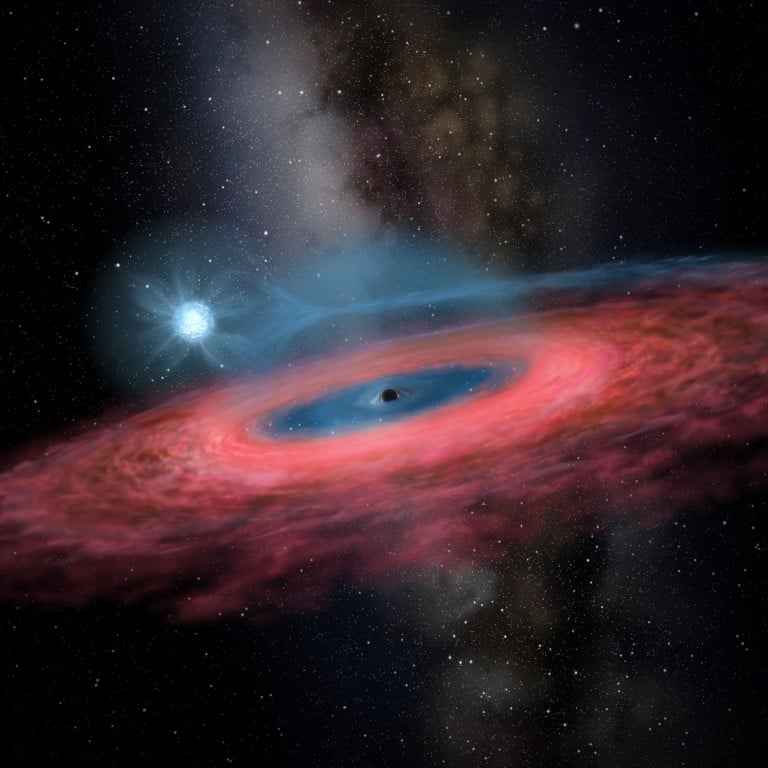
Chinese astronomers discover ‘impossibly massive’ black hole LB-1
- Scientists from National Astronomical Observatory of China say find has 70 times the mass of the sun, even though physics says that is impossible
- Black hole found using world’s largest galaxy scanner, the Large Sky Area Multi-Object Fibre Spectroscopic Telescope in northern China
Chinese astronomers have discovered a black hole in the Milky Way that present scientific theory says is too big to exist.
Scientists from the National Astronomical Observatory of China say the find, dubbed LB-1, has 70 times the mass of the sun, even though physics says that is impossible.
“We were so shocked we could not believe what we saw,” researcher Liu Jifeng said in Beijing on Thursday.
He said he and his colleagues consulted astronomers from around the world and after three years of fact-checking announced their find in an article published by the scientific journal Nature.
Present theory says that stars are made up of various elements, ranging from light gas to heavy metals. Lighter elements are converted into heavier ones by thermal nuclear reactions at their core, releasing a massive amount of energy in the process.

But according to Einstein’s famous equation, E=mc², a star’s mass should reduce over time as it is converted into energy. Some particles might also escape through solar wind so that the star dims and collapses to become a neutron star or a black hole.
If that theory is correct, a star similar to the sun could not produce a black hole with a mass equal to that of LB-1.
Possible cracks in the theory began to appear in 2015 with the detection of gravitational waves. These ripples of gravity in the universe suggested the existence of a black hole 60 times more massive than the sun, but GW150914, as it was called, was located in a distant part of the universe that has stars very different from our sun.
Most scientists believed it was formed by the merging of two black holes instead of a single star, hence generating the gravitational waves.
The discovery of LB-1 has made people think again.
“It cannot be explained by initial mass, or stellar wind, or thermal nuclear reactions. It toppled our perceptions about star evolution and black hole formation,” said Li Xiangdong, a professor of astronomy at Nanjing University and member of the LB-1 discovery team.
The researchers found the black hole using the Large Sky Area Multi-Object Fibre Spectroscopic Telescope, the world’s largest galaxy scanner located near Beijing in northern China’s Hebei province.
It comprises 4,000 small lenses, each of which can be focused on a separate target.
How a young Chinese woman is mentoring scientists of the future
Professor Wu Xuebing, an astronomer with Peking University who was not involved in the project, said the discovery of LB-1 was more than just luck.
He said China had some of the world’s most advanced research equipment, so it was “about time” its scientists made a contribution to the advancement of human knowledge, he said.
“There are many unknowns waiting for us.”
While it is unlikely that Einstein’s theory of general relativity is wrong, the discovery of LB-1 suggests there may be gaps in it.
“This is an incredible discovery. I feel truly lucky to be living in an era of discoveries,” said Bangalore Sathyaprakash, a professor of astronomy and astrophysics at Penn State University in the United States.
Dr David Reitze, executive director of the LIGO laboratory at the California Institute of Technology, compared the discovery to the Nobel-winning work of gravitational wave detection.
“The discovery of a 70 solar-mass black hole, in our own galaxy no less, forces us to re-examine our models of how stellar-mass black holes form,” he said.
“This remarkable result along with the LIGO-Virgo detections of binary black hole collisions during the past four years really points towards a coming renaissance in our understanding of black hole astrophysics.”

